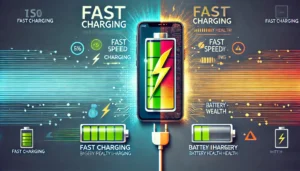Fast charging delivers more power (measured in watts) to your device’s battery in a shorter amount of time. This is achieved by increasing the current (amps), voltage, or both. Technologies like Qualcomm Quick Charge, USB Power Delivery (USB-PD), and proprietary solutions from manufacturers like Apple and Samsung enable this.
Most modern devices use lithium-ion batteries, which charge in two phases:
- Constant Current Phase: The battery charges rapidly up to about 80%.
- Trickle Charging Phase: The charging speed slows down as the battery nears 100% to prevent overheating.
Fast charging optimizes the first phase, significantly reducing the time it takes to charge your device.

How Fast Charging Affects Battery Health
While fast charging is convenient, it can influence battery health over time. Here’s how:
1. Increased Heat Generation
Fast charging generates more heat than standard charging. Since heat is one of the biggest enemies of lithium-ion batteries, prolonged exposure to high temperatures can degrade the battery’s chemical components, reducing its overall lifespan.
2. Higher Stress on Battery Cells
Fast charging pushes more current into the battery in a short time. This stresses the battery cells, causing them to wear out faster, especially if the feature is used frequently.
3. Impact on Charge Cycles
Lithium-ion batteries have a limited number of charge cycles (usually between 300-500 full cycles). Fast charging can accelerate the rate at which these cycles are consumed, leading to a shorter usable life.
Myths vs. Reality
- Myth: Fast charging will ruin your battery immediately.
Reality: Modern devices come with sophisticated battery management systems (BMS) to minimize damage. These systems regulate power input and prevent overheating. - Myth: Using a fast charger on a non-certified device is fine.
Reality: Non-certified chargers or cables can overheat and damage your battery, as they might not comply with safety standards.
How to Minimize Battery Degradation with Fast Charging
- Use Certified Chargers and Cables
Always use chargers and cables from the device manufacturer or certified third-party brands. - Avoid Excessive Heat
Remove your phone case while charging and avoid charging in hot environments. - Don’t Charge to 100% or Drain to 0% Regularly
Keeping your battery between 20% and 80% can significantly extend its lifespan. - Limit Fast Charging Usage
Use fast charging only when necessary, and rely on standard charging for regular use. - Update Your Device
Ensure your device firmware is up-to-date. Manufacturers often release updates that optimize battery performance.
